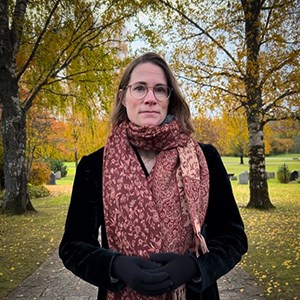- We will all end up there one day, so everyone has a relationship with the burial place, says Helena Nordh, professor of landscape architecture with a focus on design theory at SLU.
Her research shows that burial grounds fulfill a number of different functions for us today. In addition to a resting place for those who are no longer with us, as densification intensifies, cemeteries are also used more for recreation - for walks or sitting down and resting for a while.
- Several of the visitors I've spoken to talk about tranquility, nature experiences, the well-kept environment and the traces of history as something they particularly appreciate.
Important for recreation
The burial ground is therefore not only a place for the dead - it also plays a major role for the living, which makes it both exciting and complex.
- It is public but consists of many private graves, it works as a resting place for the dead but is also a place for the living.
In recent years, the cemetery landscape has changed, says Helena Nordh. It is about changed management to increase biological diversity, but also about an increased interest in memorials of various kinds (Askgravlund, Askgravplats, Minneslund).
A landscape of passage
- Cemeteries are kind of a landscape of passage - a place between life and death. The proximity to death creates spirituality. There is a risk that the spirituality of the cemeteries will decrease when the headstones disappear.
Another change is that there are burial plots for different denominations. As Sweden becomes more multicultural, the need for coffin burial graves increases, which can be a challenge as our cities become denser. In some religions, coffin burial is the only option.
This development increases the requirements for a flexible funeral service that meets different needs and wishes, for example with information in different languages.
The future of the cemetery
- The burial authorities need to be open and accommodating to promote inclusion. Dialogue with faith communities is important. You shouldn't generalise, but be open to the fact that there may be variations even among individuals within the same religious community.
In ten years' time, she predicts that our cemeteries will be more forest and meadow-like.
- Perhaps there will be places where relatives can scatter ashes themselves, more burial plots aimed at different religious communities and zones where recreation of various kinds is encouraged.
